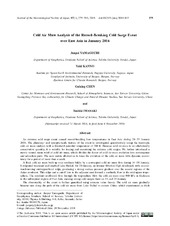| dc.contributor.author | Yamaguchi, Junpei | |
| dc.contributor.author | Kanno, Yuki | |
| dc.contributor.author | Chen, Guixing | |
| dc.contributor.author | Iwasaki, Toshiki | |
| dc.date.accessioned | 2020-08-18T07:36:10Z | |
| dc.date.available | 2020-08-18T07:36:10Z | |
| dc.date.issued | 2019 | |
| dc.Published | Yamaguchi J, Kanno, Chen G, Iwasaki T. Cold Air Mass Analysis of the Record-Breaking Cold Surge Event over East Asia in January 2016. Journal of the Meteorological Society of Japan. 2019;97(1):275-293 | eng |
| dc.identifier.issn | 0026-1165 | en_US |
| dc.identifier.uri | https://hdl.handle.net/1956/23837 | |
| dc.description.abstract | An extreme cold surge event caused record-breaking low temperatures in East Asia during 20-25 January 2016. The planetary- and synoptic-scale feature of the event is investigated quantitatively using the isentropic cold air mass analysis with a threshold potential temperature of 280 K. Because cold air mass is an adiabatically conservative quantity, it is suitable for tracing and examining the extreme cold surges. We further introduced a metric named mean wind of cold air mass, which divides the factor of cold air mass evolution into convergence and advection parts. The new metric allowed us to trace the evolution of the cold air mass with dynamic consistency for a period of more than a week. A thick cold air mass built up over southern Sakha by a convergent cold air mass flow during 16-18 January. It migrated westward and reached Lake Baikal. On 20 January, an intense Siberian High developed, with an eastward-moving mid-upper-level ridge, producing a strong surface pressure gradient over the coastal regions of the Asian continent. This ridge and a cutoff low to the adjacent east formed a northerly flow in the mid-upper troposphere. The resultant southward flow through the troposphere blew the cold air mass over 480 hPa in thickness to the subtropical region of East Asia, causing strong cold surges there on 24 and 25 January. The abnormality of the event is further quantified using extreme value theory. The cold air mass gradually became rare along the path of the cold air mass from Lake Baikal to eastern China, which experienced as thick a cold air mass as once in 200 years. The cold air mass itself shows little change in thickness. Therefore, the migration of a cold air mass over 540 hPa in thickness from northern Siberia is the major cause of this cold surge extreme. | en_US |
| dc.language.iso | eng | eng |
| dc.publisher | Meteorological Society of Japan | en_US |
| dc.rights | Attribution CC BY | eng |
| dc.rights.uri | http://creativecommons.org/licenses/by/4.0/ | eng |
| dc.title | Cold Air Mass Analysis of the Record-Breaking Cold Surge Event over East Asia in January 2016 | en_US |
| dc.type | Peer reviewed | |
| dc.type | Journal article | |
| dc.date.updated | 2020-02-10T15:54:17Z | |
| dc.description.version | publishedVersion | en_US |
| dc.rights.holder | Copyright 2019 The Authors | en_US |
| dc.identifier.doi | https://doi.org/10.2151/jmsj.2019-015 | |
| dc.identifier.cristin | 1723319 | |
| dc.source.journal | Journal of the Meteorological Society of Japan | |

